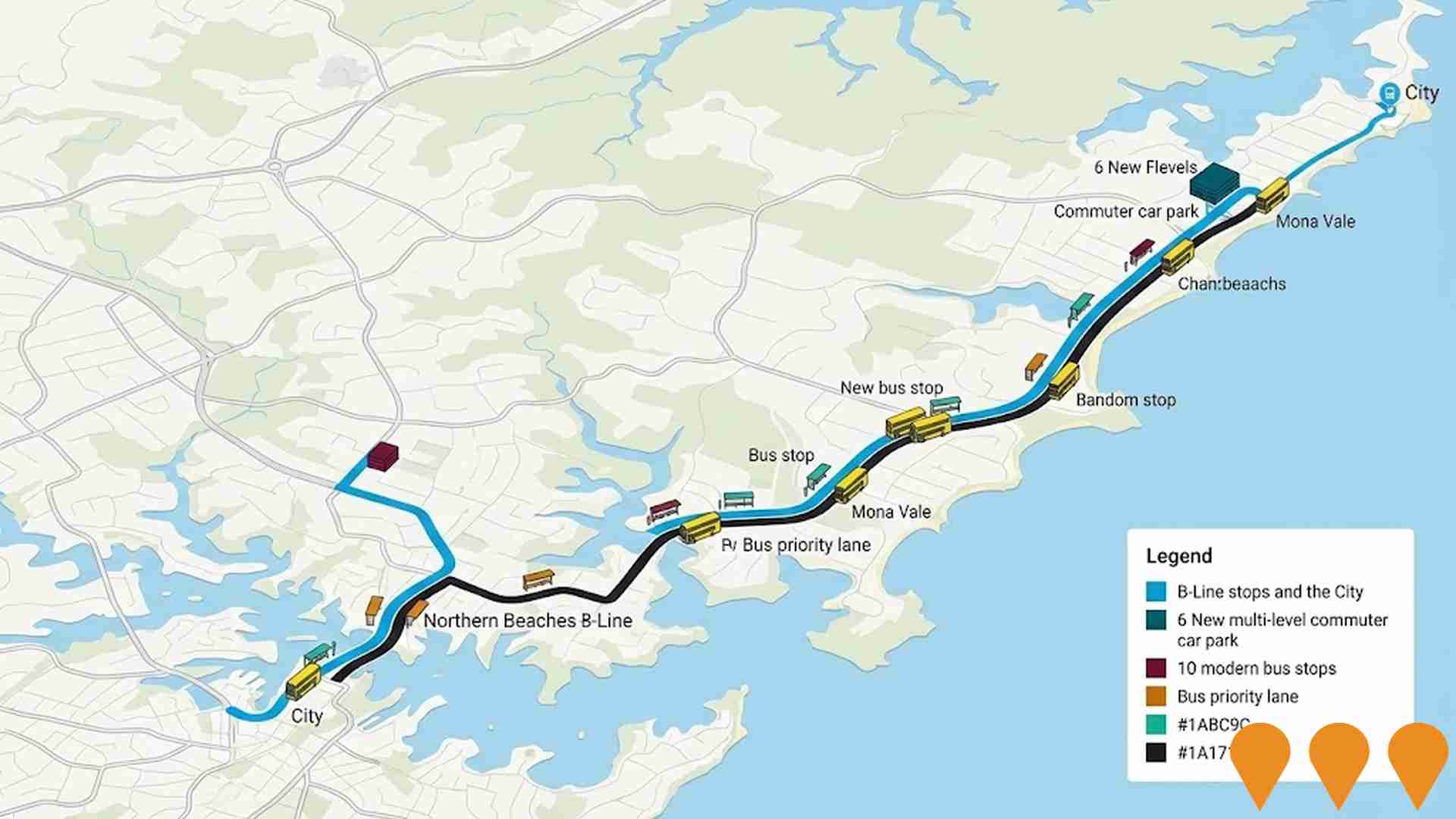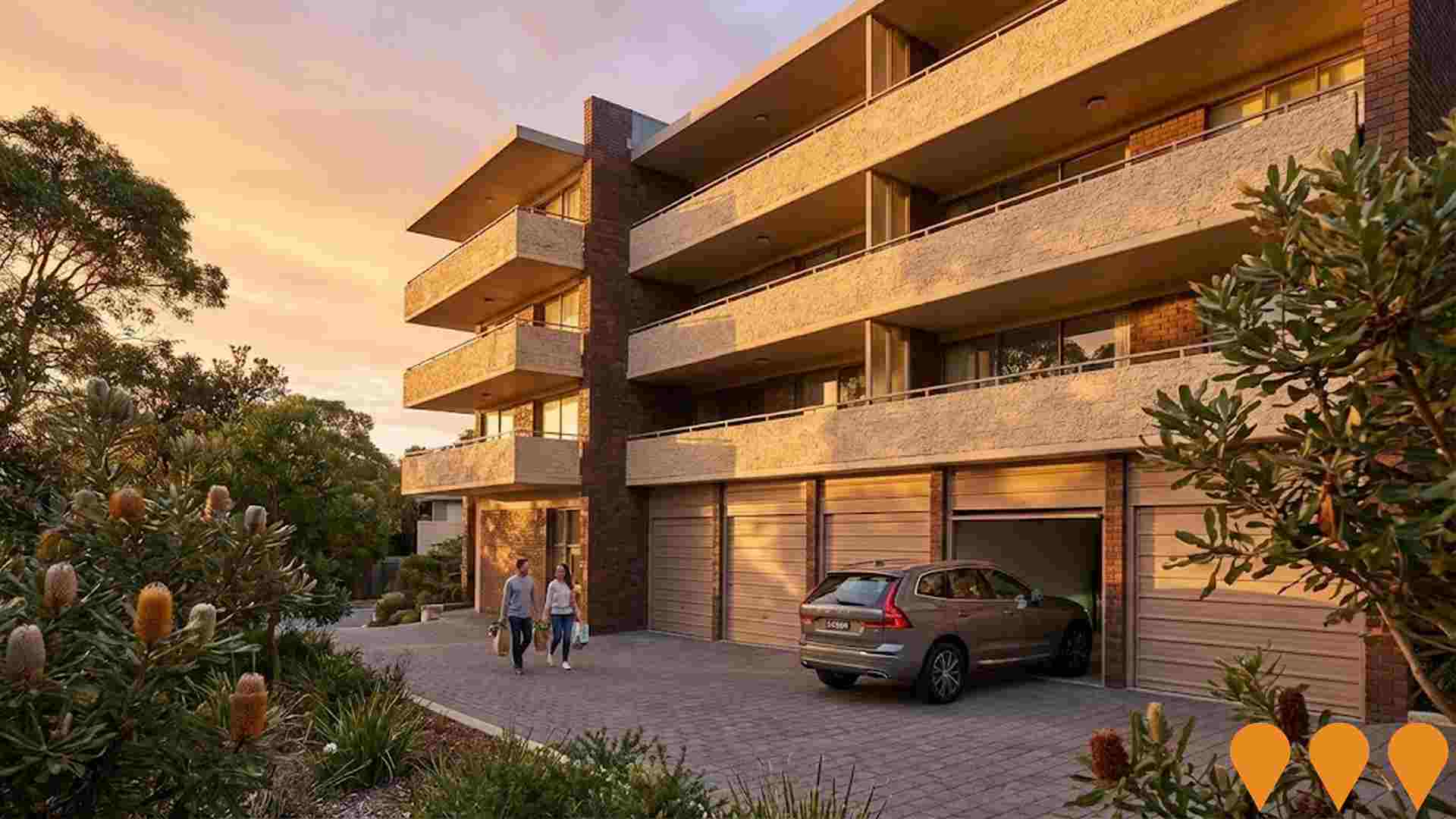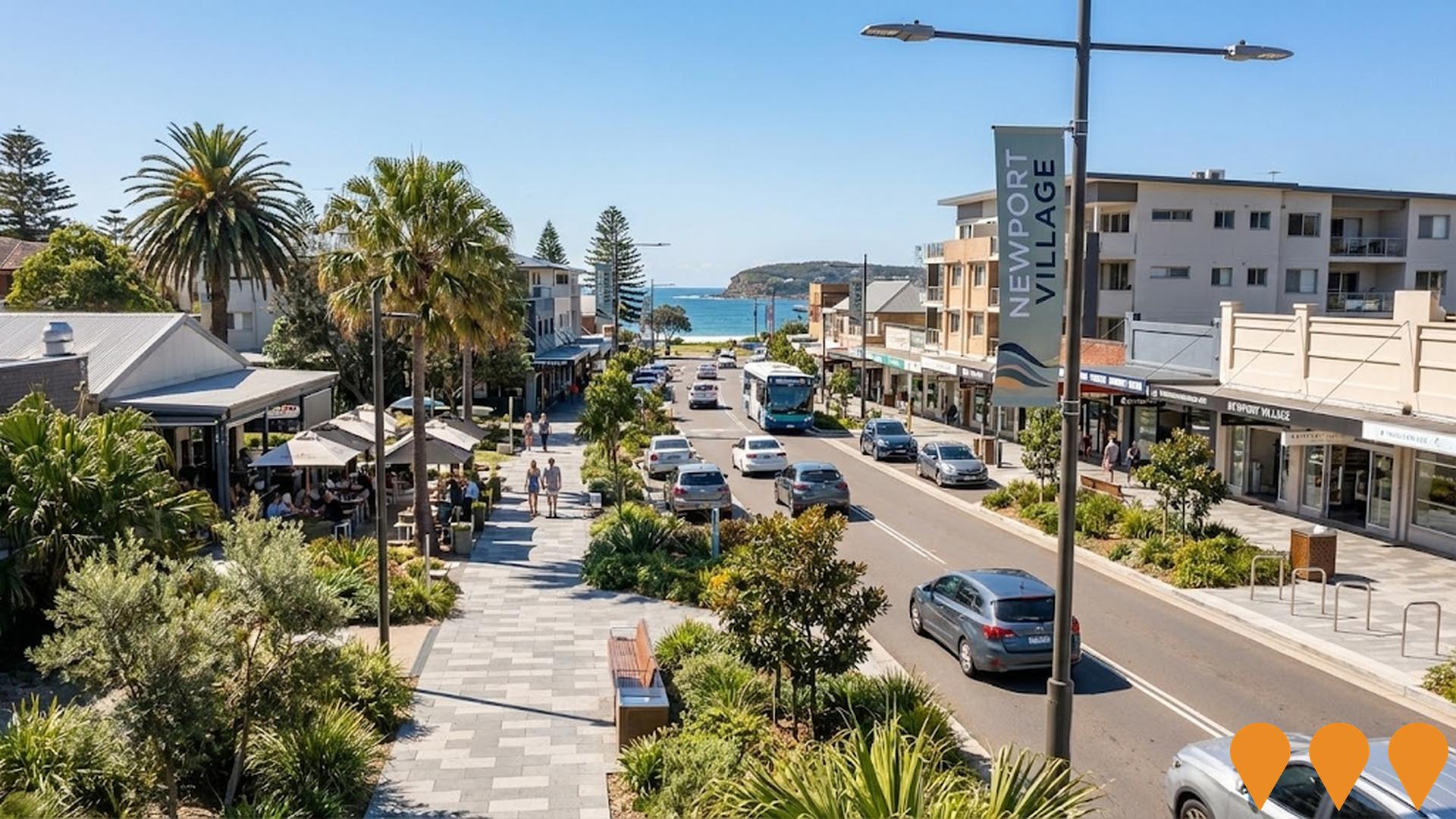Chart Color Schemes
est. as @ -- *
ABS ERP | -- people | --
2021 Census | -- people
Sales Activity
Curious about local property values? Filter the chart to assess the volume and appreciation (including resales) trends and regional comparisons, or scroll to the map below view this information at an individual property level.
Find a Recent Sale
Sales Detail
Population
Newport - Bilgola is positioned among the lower quartile of areas assessed nationally for population growth based on AreaSearch's assessment of recent, and medium term trends
Newport-Bilgola's population, as of August 2025, is approximately 13,902, marking a 1.6% increase from the 2021 Census figure of 13,681 people. This growth is inferred from the estimated resident population of 13,846 in June 2024 and an additional 53 validated new addresses since the Census date. The population density stands at 2,396 persons per square kilometer, placing it in the upper quartile nationally according to AreaSearch's assessments. Newport-Bilgola's growth rate of 1.6% since the census is within 0.1 percentage points of its SA3 area (1.7%), indicating strong growth fundamentals. Overseas migration contributed approximately 68.2% of overall population gains during recent periods. AreaSearch uses ABS/Geoscience Australia projections for each SA2 area, released in 2024 with a base year of 2022.
For areas not covered by this data, AreaSearch utilises NSW State Government's SA2 level projections from 2022 using the 2021 Census as the base year. These growth rates by age group are applied to all areas for years 2032 to 2041. By 2041, population projections indicate lower quartile growth nationally, with Newport-Bilgola expected to grow by 94 persons, representing a total gain of 0.3% over the 17-year period.
Frequently Asked Questions - Population
Development
AreaSearch assessment of residential development drivers sees a low level of activity in Newport - Bilgola, placing the area among the bottom 25% of areas assessed nationally
Newport Bilgola has seen approximately 32 dwelling approvals annually over the past five financial years, totalling 164 homes. As of FY2025-26, four approvals have been recorded. Despite a decline in population during this period, development activity has been relatively adequate, benefiting buyers while new properties are constructed at an average cost of $1,012,000, indicating a focus on premium segments. This year, $841,000 in commercial approvals have been registered, reflecting the area's residential nature.
Compared to Greater Sydney, Newport Bilgola shows 19.0% lower construction activity per person and ranks among the 31st percentile nationally, suggesting limited buyer options but strong demand for established properties. This lower activity may indicate market maturity or potential development constraints. In terms of housing types, 54.0% are standalone homes while 46.0% are medium to high-density housing, marking a shift from existing patterns (currently 73.0% houses), possibly due to diminishing developable land and evolving lifestyle preferences. With around 564 people per approval, Newport Bilgola is considered an established area. Population forecasts indicate an increase of 38 residents by 2041.
Given current construction levels, housing supply should meet demand adequately, creating favourable conditions for buyers while potentially enabling growth beyond current forecasts.
Frequently Asked Questions - Development
Infrastructure
Newport - Bilgola has very high levels of nearby infrastructure activity, ranking in the top 10% nationally
Changes to local infrastructure significantly influence an area's performance. AreaSearch has identified 14 projects likely to impact the area. Notable projects include IPM Ocean Road Newport Development, Kenza Newport, Robertson Road Corner Site Development, and The Moorings Newport. The following list details projects likely to be most relevant.
Professional plan users can use the search below to filter and access additional projects.
INFRASTRUCTURE SEARCH
 Denotes AI-based impression for illustrative purposes only, not to be taken as definitive under any circumstances. Please follow links and conduct other investigations from the project's source for actual imagery. Developers and project owners wishing us to use original imagery please Contact Us and we will do so.
Denotes AI-based impression for illustrative purposes only, not to be taken as definitive under any circumstances. Please follow links and conduct other investigations from the project's source for actual imagery. Developers and project owners wishing us to use original imagery please Contact Us and we will do so.
Frequently Asked Questions - Infrastructure
Mona Vale Hospital Reconfiguration
NSW Health Infrastructure has completed the reconfiguration of Mona Vale Hospital to focus on rehabilitation, sub-acute and community health services. Works included establishing a 20-bed geriatric evaluation and management and palliative care building (10-bed GEM and 10-bed palliative), creating an urgent care centre from the former ED, a new support services building, helipad relocation, and demolition of redundant buildings. The program complements services at Northern Beaches Hospital and ensures ongoing local access to appropriate care.

Northern Beaches B-Line Program
The B-Line Program was an integrated package of service and infrastructure improvements providing a frequent and reliable bus service between Mona Vale and the Sydney CBD. It included a new fleet of high-frequency double-decker buses, six new commuter car parks (providing around 900 new spaces), ten modern B-Line bus stops, roadwork, and bus priority measures to reduce congestion. All project construction and roadwork are complete, with the project largely operational by 2017-2020. Minor rectification works and public art installations were finalised in late 2019.

IPM Ocean Road Newport Development
Mixed-use development by IPM at Ocean Road Newport featuring residential apartments and commercial spaces. Part of IPM's $200 million Northern Beaches development pipeline.

Newport Village Commercial Centre Masterplan
A masterplan adopted by the former Pittwater Council in November 2007 to establish a holistic vision for the Newport Village Commercial Centre. The plan focuses on enhancing public spaces, traffic calming, and mixed uses to create a vibrant seaside village hub. It provides an urban design framework, and its principles are incorporated into the Pittwater Development Control Plan (DCP) to guide future development in the area. The masterplan has been used to assess subsequent development applications in the village.

Mona Vale Place Plan
Comprehensive revitalisation plan for Mona Vale village centre. Currently on hold pending NSW Government Stage 2 housing reforms which were released February 2025.

Newport Surf Life Saving Club Alterations and Additions
Alterations and additions to the heritage-listed surf club building, including a new contemporary northern extension to improve amenity and functionality, and coastal protection works in the form of a buried seawall along the length of the building to mitigate erosion risk. The project will provide increased storage, a new internal lift, dedicated training rooms, and enhanced community and club spaces.

The Moorings Newport
An exclusive collection of eight luxury waterfront homes/lots with private 25-30 metre enclosed marina pens on Winji Jimmi Bay, Pittwater, offering buyers the option to acquire a custom-designed home by Scott Carver or to build their own. The development is on the site of the former Sirsi Marina.

Qubec Newport
An exclusive, luxury, and sustainable townhome development with 18 residences in Newport, NSW. Features include polished concrete, smart home technology, private elevators, individual solar power and battery storage, EV charging, and biometric/numberplate recognition access. The project was completed in 2023.

Employment
Employment performance in Newport - Bilgola exceeds national averages across key labour market indicators
Newport Bilgola has a highly educated workforce with significant representation in the technology sector. Its unemployment rate was 3.2% as of June 2025.
The area had 7,856 residents employed at that time, which is 1.0% below Greater Sydney's unemployment rate of 4.2%. Workforce participation in Newport Bilgola was 65.1%, compared to Greater Sydney's 60.0%. Key industries for employment among residents were professional & technical, construction, and health care & social assistance. Construction showed particularly strong specialization with an employment share of 1.4 times the regional level.
However, transport, postal & warehousing was under-represented at 2.6% compared to Greater Sydney's 5.3%. Limited local employment opportunities were indicated by the count of Census working population versus resident population. In the 12-month period ending June 2025, labour force remained unchanged while employment declined by 1.0%, causing unemployment to rise by 1.0 percentage points. Conversely, Greater Sydney saw employment growth of 2.6% and labour force growth of 2.9%, with a 0.3 percentage point rise in unemployment. Jobs and Skills Australia's national employment forecasts from May 2025 suggest that national employment will expand by 6.6% over five years and 13.7% over ten years. Applying these projections to Newport Bilgola's employment mix indicates potential local growth of approximately 6.9% over five years and 14.0% over ten years, though these are simple extrapolations for illustrative purposes only.
Frequently Asked Questions - Employment
Income
Income metrics indicate excellent economic conditions, with the area achieving higher performance than 75% of national locations assessed by AreaSearch
Newport-Bilgola has a median taxpayer income of $58,932 and an average income of $108,744, according to the latest postcode level ATO data aggregated by AreaSearch for financial year 2022. This is notably high compared to Greater Sydney's median income of $56,994 and average income of $80,856. Based on Wage Price Index growth of 12.61% since financial year 2022, estimated incomes as of September 2025 would be approximately $66,363 (median) and $122,457 (average). According to the 2021 Census, household, family, and personal incomes in Newport-Bilgola rank highly nationally, between the 87th and 93rd percentiles. Income analysis shows that the $4000+ bracket dominates with 32.4% of residents (4,504 people), contrasting with regional levels where the $1,500 - 2,999 bracket leads at 30.9%. Newport-Bilgola exhibits significant affluence, with 44.5% earning over $3,000 per week, supporting premium retail and service offerings. High housing costs consume 15.2% of income, yet strong earnings place disposable income at the 92nd percentile nationally. The area's SEIFA income ranking places it in the 10th decile.
Frequently Asked Questions - Income
Housing
Newport - Bilgola is characterized by a predominantly suburban housing profile, with a higher proportion of rental properties than the broader region
Newport-Bilgola's dwelling structure, as per the latest Census, consists of 73.0% houses and 26.9% other dwellings (semi-detached, apartments, 'other' dwellings). This is compared to Sydney metro's 73.0% houses and 27.9% other dwellings. Home ownership in Newport-Bilgola stands at 41.5%, with mortgaged dwellings at 39.1% and rented at 19.4%. The median monthly mortgage repayment is $3,033, below Sydney metro's average of $3,200. Median weekly rent in Newport-Bilgola is $628, compared to Sydney metro's $695. Nationally, mortgage repayments are higher at $1,863 and rents are substantially above the national figure of $375.
Frequently Asked Questions - Housing
Household Composition
Newport - Bilgola features high concentrations of family households, with a fairly typical median household size
Family households constitute 78.1% of all households, including 37.2% couples with children, 31.7% couples without children, and 8.5% single parent families. Non-family households account for 21.9%, with lone person households at 19.9% and group households comprising 2.0%. The median household size is 2.7 people, aligning with the Greater Sydney average.
Frequently Asked Questions - Households
Local Schools & Education
Educational achievement in Newport - Bilgola places it within the top 10% nationally, reflecting strong academic performance and high qualification levels across the community
The area's educational profile is notable regionally, with university qualification rates at 39.7% of residents aged 15+, surpassing the Australian average of 30.4% and NSW's average of 32.2%. Bachelor degrees are most prevalent at 27.4%, followed by postgraduate qualifications (9.0%) and graduate diplomas (3.3%). Vocational credentials are also prominent, with 33.1% of residents aged 15+ holding such qualifications – advanced diplomas comprise 14.5% and certificates make up 18.6%.
Educational participation is high, with 28.3% of residents currently enrolled in formal education. This includes 8.8% in primary education, 8.8% in secondary education, and 5.3% pursuing tertiary education. Newport Public School and Bilgola Plateau Public School serve a total of 911 students in the area. The ICSEA score for this area is 1108, indicating significant socio-educational advantages and academic achievement. Both schools focus on primary education, with secondary options available nearby. There are 6.5 school places per 100 residents, which is lower than the regional average of 12.7, suggesting some students may attend schools in adjacent areas.
Frequently Asked Questions - Education
Schools Detail
Nearby Services & Amenities
Transport
Transport servicing is moderate compared to other areas nationally based on assessment of service frequency, route connectivity and accessibility
Newport-Bilgola has 61 active public transport stops. These include a mix of ferry and bus services. There are 36 individual routes operating in total, providing 1,839 weekly passenger trips collectively.
The area's transport accessibility is rated as good, with residents typically located 218 meters from the nearest stop. On average, there are 262 trips per day across all routes, equating to approximately 30 weekly trips per individual stop.
Frequently Asked Questions - Transport
Transport Stops Detail
Health
Newport - Bilgola's residents boast exceedingly positive health performance metrics with very low prevalence of common health conditions across all age groups
Health outcomes data shows excellent results across Newport-Bilgola with a very low prevalence of common health conditions across all age groups. Approximately 75% of the total population (10,468 people) has private health cover, significantly higher than the national average of 55.3%.
The most prevalent medical conditions in the area are arthritis and asthma, affecting 7.6 and 6.3% of residents respectively. A majority, 73.6%, reported being completely free from medical ailments, slightly higher than the Greater Sydney average of 72.8%. As of June 2021, 22.9% of residents are aged 65 and over (3,180 people), which is lower than the 24.1% in Greater Sydney. Health outcomes among seniors in Newport-Bilgola are particularly strong, outperforming those of the general population in health metrics.
Frequently Asked Questions - Health
Cultural Diversity
In terms of cultural diversity, Newport - Bilgola records figures broadly comparable to the national average, as found in AreaSearch's assessment of a number of language and cultural background related metrics
Newport-Bilgola's cultural diversity was found to be roughly in line with the wider region, with 75.6% of its population born in Australia, 91.0% being citizens, and 92.9% speaking English only at home. Christianity was found to be the main religion, comprising 48.0% of people in Newport-Bilgola. Judaism showed an overrepresentation with 0.4% of the population compared to 0.3% across Greater Sydney.
The top three ancestry groups were English (33.6%), Australian (23.1%), and Irish (9.8%). Notably, French (0.9%) was slightly overrepresented compared to the regional average of 0.8%, as were Scottish (9.3% vs 8.7%) and South African (0.9% vs 0.8%).
Frequently Asked Questions - Diversity
Age
Newport - Bilgola hosts an older demographic, ranking in the top quartile nationwide
The median age in Newport-Bilgola is 46 years, which is higher than Greater Sydney's average of 37 years and also exceeds the Australian median of 38 years. The 55-64 age cohort is notably over-represented in Newport-Bilgola at 16.5%, compared to Greater Sydney's average of 12.9% and the national average of 11.2%. Conversely, the 25-34 age group is under-represented locally at 7.3%, compared to Greater Sydney's average of 10.8%. Between the 2021 Census and the latest data, the population aged 15-24 has grown from 11.8% to 13.8%, while those aged 75-84 increased from 6.7% to 8.2%. Meanwhile, the 5-14 age group has declined from 12.4% to 10.9%, and the 25-34 cohort has dropped from 8.5% to 7.3%. Population forecasts for 2041 indicate significant demographic changes in Newport-Bilgola, with the 85+ age cohort projected to increase dramatically by 411 people (130%), from 316 to 728. The aging population trend is evident, as those aged 65 and above will account for all of the projected growth. Conversely, the 55-64 and 25-34 age cohorts are expected to experience population declines.